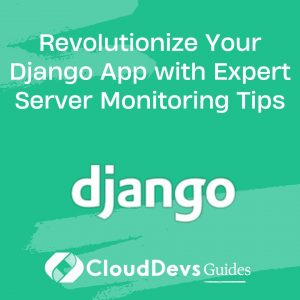Revolutionize Your Django App with Expert Server Monitoring Tips
Monitoring your Django application’s health and performance is crucial in today’s fast-paced digital world. With businesses increasingly dependent on web applications, ensuring your Django app runs smoothly and efficiently is paramount. This post dives into the essentials of server monitoring, focusing on strategies and tools to keep your Django app at peak performance. You can hire Django Developers for your projects to ensure greater success.
Table of Contents
1. Understanding Server Monitoring
Server monitoring involves tracking various metrics and logs to understand an application’s health and performance. For Django applications, this means looking at both the application layer and the underlying server infrastructure.
Read more: Django Documentation
2. Key Metrics to Monitor
- Response Time: Measures how long it takes your Django app to respond to a request. High response times could indicate server overload or inefficient code.
- Error Rates: Tracks the frequency of errors. An increase in error rates can signal issues in your application or its dependencies.
- Traffic Patterns: Understanding traffic patterns helps in scaling your server resources appropriately.
- Database Performance: Since Django often relies on databases, monitoring database performance is crucial. Look at query execution times and connections.
- Resource Utilization: Keep an eye on CPU, memory, and disk usage. Spikes in usage can indicate underlying problems.
3. Tools for Monitoring
Several tools can help with Django server monitoring. Here are a few:
– New Relic: Offers comprehensive application performance management. Ideal for tracking response times and error rates. [New Relic](#)
– Datadog: Provides real-time performance tracking and is especially good at visualizing metrics. [Datadog](#)
– Prometheus and Grafana: A powerful combination for monitoring metrics and creating dashboards. [Prometheus](#) | [Grafana](#)
Read more: Atatus APM
4. Implementing Monitoring in Django
To effectively monitor your Django app, you need to implement logging and integrate monitoring tools.
Read more: Earthly Blog
5. Logging
Django comes with a built-in logging module. Configure it to capture warnings, errors, and critical information about the application’s operation. This data is invaluable for troubleshooting.
5.1. Integration with Monitoring Tools
Integrate Django with tools like New Relic or Datadog. This usually involves adding middleware to your Django app that sends metrics to these services.
5.2. Custom Metrics
Sometimes, you may need to monitor specific aspects of your application. Django allows you to define custom metrics, which can be tracked alongside standard metrics.
6. Best Practices for Server Monitoring
- Regular Audits: Regularly audit your monitoring setup to ensure it covers all critical aspects of your application.
- Alerts and Thresholds: Set up alerts for critical metrics to be notified of potential issues promptly.
- Performance Baselines: Establish performance baselines to quickly identify anomalies.
- Scalability: Ensure your monitoring setup is scalable, just like your application.
- Security: Always consider the security implications of your monitoring tools and data.
Read more: Toptal
7. Case Studies and Examples
- E-commerce Platform: An e-commerce site using Django noticed intermittent downtime during high-traffic events. By implementing comprehensive monitoring, they identified inefficient database queries as the culprit. Optimization of these queries resolved the issue.
- Educational Website: A Django-based educational platform experienced slow page loads. Monitoring revealed that the server’s CPU usage spiked during peak hours. They scaled their server resources, significantly improving performance.
Conclusion
Monitoring your Django application’s health and performance is not just about keeping it running; it’s about ensuring it runs optimally. With the right tools and practices, you can anticipate issues, improve performance, and provide a better user experience. Remember, a well-monitored application is often a well-performing application.
You can check out our other blog posts to learn more about Django. We bring you a complete guide titled Django Real-time Alerts: A Push Notification Guide along with the Master Real-Time Communication in Django Apps with WebSockets and The Essential Guide to Social Logins in Django with OAuth and OpenID which will help you understand and gain more insight into the Django programming language.
Table of Contents







